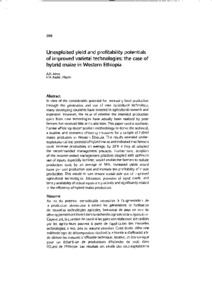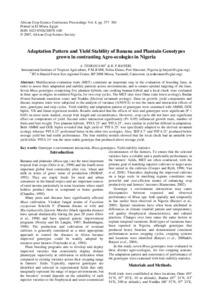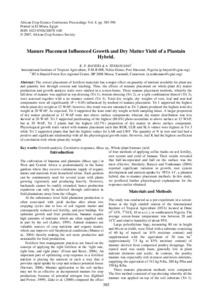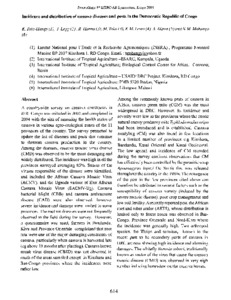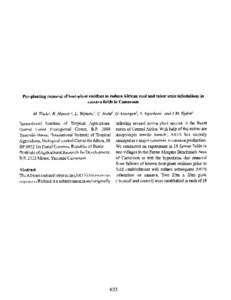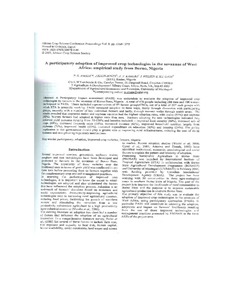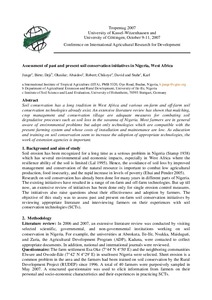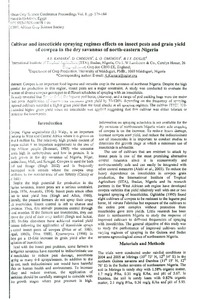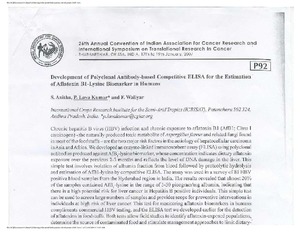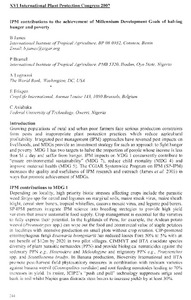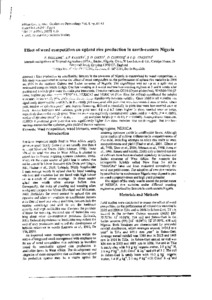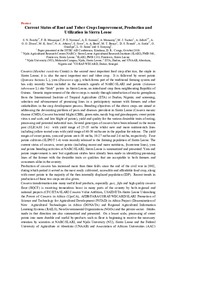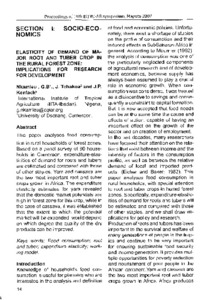Welcome to the International Institute of Tropical Agriculture Research Repository
Conference Documents: Recent submissions
Now showing items 641-660 of 726
-
Unexploited yield and profitability potentials of improved varietal technologies: the case of hybrid maize in Western Ethiopia
(International Institute of Tropical Agriculture, 2007)In view of the considerable potential for increasing food production through the generation and use of new agricultural technology, many developing countries have invested in agricultural research and extension. However, the issue of whether he intended production gains from new technologies have actually been realized by poor farmers has received little or no attention. This peruseda stochastic frontier efficiency decomposition methodology to derive the technical, allocative, and economic ... -
Adaptation pattern and yield stability of banana and plantain genotypes grown in contrasting agro-ecologies in Nigeria
(African Crop Science Society, 2007)Multilocation evaluation trials (MET) constitute an important step in the evaluation of breeding lines, in order to assess their adaptation and stability patterns across environments, and to ensure optimal targeting of the lines. Seven Musa genotypes comprising five plantain hybrids, one cooking banana hybrid and a local check were evaluated in three agro-ecologies in southern Nigeria, for two crops cycles. The MET sites were Onne (rain forest ecology), Ibadan (Forest-Savannah transition zone) and ... -
Manure placement influenced growth and dry matter yield of a plantain hybrid
(African Crop Science Society, 2007)The correct placement of fertilizer materials has a major effect on quantity of nutrient available for plant use and quantity lost through erosion and leaching. Thus, the effects of manure placement on whole-plant dry matter production and growth analysis traits were studied in a screen-house. Three manure placement methods, whereby they full dose of manure was applied as top-dressing (Trt 2), or a split combination thereof (Trt 3), were assessed together with a no manure control (Trt 4). Total ... -
Evaluation of advanced peanut breeding lines for resistance to late leaf spot and rust
(American Peanut Research and Education Society, 2007) -
Incidence and distribution of cassava diseases and pests in the Democratic Republic of Congo
(International Society For Tropical Root Crops-Africa Branch, 2007)A countrywide survey on cassava constraints in D.R. Congo was initiated in 2002 and completed in 2004 with the aim of assessing the health status of cassava in various agro-ecological zones of the 11 provinces of the country. The survey permitted to update the list of diseases and pests that continue to threaten cassava production in the country. Among the diseases, cassava mosaic virus disease (CMD) was observed to be the most damaging and widely distributed. The incidence was high in all ... -
Biological control of cassava green mite in Tanzania
(International Society For Tropical Root Crops-Africa Branch, 2007)The cassava green mite Mononychellus tanajoa (Bondar) (Acari: Tetranychidae) is one of the most important pests of cassava, a main staple food crop in Tanzania. The International Institute of Tropical Agriculture (ETA) in collaboration with the Tanzania National Biological Control P r o m (NBCP) launched in 1998 the biological control campaign against cassava green mite in Tanzania with the release of the neotropicd phytoseiid predator Z)phlodromallus aripo DeLeon (Acari: Phytoseiidae), which had ... -
Distribution and abundance of cassava pests in Tanzania with a note on the spiralling whitefly
(International Society For Tropical Root Crops-Africa Branch, 2007)Two surveys were conducted in Tanzania in May- June 2003 and June-August 2004 to determine the incidence and severity of several cassava arthropod pests including cassava green mite, cassava mealybug, spiralling whitefly, Bemisia spp., cassava scale, red mite, Zonocerus elegans, and several species of termites. Cassava green mite densities were relatively low except in the Lake region in 2004. The introduced phytoseiid predator of cassava green mite Typhlodromalus aripo was found in all regions, ... -
Distribution, incidence and severity of cassava diseases and pests in Mozambique
(International Society For Tropical Root Crops-Africa Branch, 2007)Two countrywide surveys were conducted in April-May and May-June 2004 throughout the cassava growing belt of Mozambique including several provinces: Gaza, Inhambane, Sofala, Manica, Zambezia, Nampula and Cabo Delgado. Both surveys were planned to assess the distribution, incidence and damage severity of diseases and pests that affect cassava production in Mozambique. Using the methodology developed by the International Institute of Tropical Agriculture (IITA), 202 and 175 cassava fields between ... -
Pre-planting removal of host-plant residues to reduce African root and tuber scale infestations in cassava fields in Cameroon
(International Society For Tropical Root Crops-Africa Branch, 2007)The African root and tuber scale (ARTS) Stictococcus vayssierei Richard is a subterranean insect originally infesting several native plant species in the forest zones of Central Africa. With help of the native ant Anoplolepis tenella Santchi, ARTS has recently emerged as a major constraint to cassava production. We conducted an experiment in 18 farmer fields in two villages in the Forest Margins Benchmark Area of Cameroon to test the hypothesis that removal from fallows of known host-plant residues ... -
A participatory adoption of improved crop technologies in the savannas of West Africa: empirical study from Borno, Nigeria
(African Crop Science Society, 2007)A Participatory Impact assessment (PASS) was undertaken to evaluate the adoption of improved crop technologies by farmers in the savannas of Borno State, Nigeria. A total of 476 people including 288 men and 188 women participated in PASS. These included representatives of 97 farmer groups/CBOs, out of a total of 287 such groups with which IITA is presently working. PASS measured adoption in three ways, firstly through discussion with participating groups, secondly with a number of key individual ... -
Assessment of past and present soil conservation initiatives in Nigeria, West Africa
(Tropentag, 2007)Soil conservation has a long tradition in West Africa and various on-farm and off-farm soil conservation technologies already exist. An extensive literature review has shown that mulching, crop management and conservation tillage are adequate measures for combating soil degradative processes such as soil loss in the savanna of Nigeria. Most farmers are in general aware of environmental problems but adopt only technologies which are compatible with the present farming system and whose costs of ... -
Evaluation of cowpea genotypes for their reactions to Striga gesnerioides in the dry savanna of northeast Nigeria
(African Crop Science Society, 2007)The parasitic weed Striga gesnerioides (Willd) Vatke is one of the most important constraints to cowpea production in the dry savanna. Yield losses due to S. gesnerioides range from 83 to 100%. No single method however seems to be fully adequate in the control of this parasite. One practice, host plant resistance, appears to have merit in effectively and economically controlling the parasite in that it is affordable to farmers. A total of 30 breeding lines including some varieties were evaluated ... -
Cultivar and insecticide spraying regimes effects on insect pests and grain yield of cowpea in the dry savannas of north-eastern Nigeria
(African Crop Science Society, 2007)Cowpea is an important food legume and versatile crop in the savannas of northeast Nigeria. Despite the high potential for production in this region, insect pests are a major constraint. A study was conducted to evaluate the response of diverse cowpea genotypes to different schedules of spraying with an insecticide. The study revealed that flower thrips the legume pod borer, (Maruca), and a range of pod sucking bugs were the major insect pests. Application of insecticides increased grain yield by ... -
Development of polyclonal antibody-based competitive ELISA for the estimation of aflatoxin B1-lysine biomarker in humans
(Indian Association for Cancer Research, 2007) -
IPM contributions to the achievement of Millennium Development Goals of halving hunger and poverty
(British Crop Protection Council, 2007) -
Effect of weed competition on upland rice production in north-eastern Nigeria
(African Crop Science Society, 2007)Rice production by smallholder farmers in the savannas of Nigeria is constrained by weed competition. A field study was conducted to assess the effect of weed competition on the performance of upland rice varieties in 2005 and 2006 in the northern Guinea and Sudan savannas of Nigeria. The experiment was set up as a split plot in randomized complete block design. One hoe weeding at 3 weeks and two hoe-weeding regimes at 3 and 6 weeks after planting and a weedy plot were the main plot treatments. ... -
Consultative Group on International Agricultural Research (CGIAR) research-for-development agenda on mycotoxins for enhanced food safety and trade
(British Crop Protection Council, 2007) -
Breeding strategies to improve maize for adaptation to low soil nitrogen in West and Central Africa
(African Crop Science Society, 2007)The moist savannas of West and Central Africa have great potential for maize grain production due to high levels of radiation and reduced incidence of pests and diseases. However, soils in this zone are generally low in organic matter and cation exchange capacity in addition to land use intensification. Improving productivity of maize in the savannas will therefore rely on improving soil fertility, ensuring efficient use of inputs and low-N tolerant maize varieties. Breeding maize for adaptation ... -
Current Status of Root and Tuber Crops Improvement, Production and Utilization in Sierra Leone
(2012-10)Cassava (Manihot esculenta Crantz) is the second most important food crop after rice, the staple in Sierra Leone; it is also the most important root and tuber crop. It is followed by sweet potato (Ipomoea batatas L.), yam (Dioscorea spp.), which forms part of the traditional farming system and has only recently been included in the research agenda of NARC/SLARI and potato (Solanum tuberosum L) aka “Irish” potato in Sierra Leone, an introduced crop from neighbouring Republic of Guinea. Genetic ... -
Elasticity of demand of major root and tuber crop in the rural forest zone: implications for research for development
(2010)This paper analyses food consumption in rural households of forest zones. Based on a panel survey of 80 households in Cameroon, expenditure-elasticities of demand for roots and tubers are estimated and compared with those of other staples. Yam and cassava are the two most important root and tuber crops grown in Africa. The expenditure elasticity estimates for yam revealed that the domestic market potentials are high in forest zone for this crop, while in the case of cassava, it was established ...

